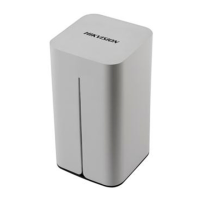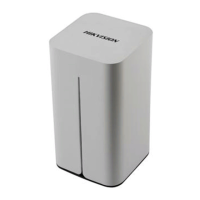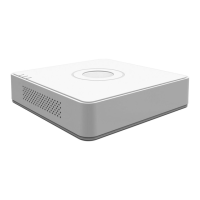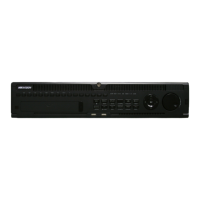
Do you have a question about the HIKVISION DS-7108NI-SN/P and is the answer not in the manual?
| Model | DS-7108NI-SN/P |
|---|---|
| Max Incoming Bandwidth | 80 Mbps |
| HDD Interface | SATA |
| HDD Slots | 1 |
| Decoding Format | H.265+/H.265/H.264+/H.264 |
| Chassis | Metal |
| Type | NVR |
| Video Input | 8 |
| HDD Capacity | Up to 4TB capacity for each HDD |
| Video Output | HDMI, VGA |
| VGA Output Resolution | 1920x1080 |
| Audio Input | 1 |
| Audio Output | 1 |
| Live View / Playback Resolution | 6MP/5MP/4MP/3MP/1080p/720p |
| Synchronous Playback | 4-ch |
| Network Interface | 1 x 10/100 Mbps |
| USB Interface | 2 x USB 2.0 |
| Power Supply | AC 100-240V, 50/60Hz |
| Operating Temperature | -10°C to +55°C |
| Operating Humidity | 10% to 90% |
| Weight | 1.5 kg |
| HDMI Output Resolution | 4K (3840×2160) |
Provides information about the NVR manual, including applicability, content, and version updates.
Acknowledges Hikvision's trademarks and logos, and those of other respective owners.
Outlines the product's warranty, liability limitations, and user responsibilities regarding usage.
Details FCC compliance statements for the digital device, including conditions for operation.
Explains CE marking, WEEE directive for disposal, and battery directive compliance.
States compliance with Industry Canada's ICES-003 standards for digital apparatus.
Provides critical warnings to prevent serious injury or death, covering security settings and electrical safety.
Offers tips for installation and operation to avoid device damage and ensure proper functioning.
Highlights general features like camera connectivity, dual-stream support, and channel configuration.
Details features for local display, including HDMITM/VGA outputs, multi-screen display, and VCA alarms.
Explains HDD connectivity, capacity limits, and management features like S.M.A.R.T. detection.
Covers recording types, schedules, pre/post-record settings, and playback capabilities.
Describes methods for exporting video data and managing backup devices.
Details alarm triggers for events like video loss, HDD full, and network disconnection.
Lists functions like front panel operation, user management, and device configuration import/export.
Covers Ethernet interfaces, PoE support, protocols like TCP/IP, and remote access features.
Describes the buttons and indicators located on the front panel of different NVR models.
Explains how to use the included IR remote control for device operation.
Details how to use a standard USB mouse for navigating the NVR interface.
Illustrates the soft keyboard layout and describes the function of its buttons.
Provides an overview of the rear panel interfaces for various NVR models.
Details the correct procedures for powering the NVR on and off to ensure device longevity.
Guides users through setting a strong administrator password for initial device activation and security.
Explains how to use the setup wizard for essential NVR configurations like date, time, and network.
Covers the process of logging into and out of the NVR system for user access control.
Details the steps for activating IP cameras and adding them to the NVR for monitoring.
Explains how to modify IP camera parameters and configure custom connection protocols.
Describes how to configure cameras connected via PoE or built-in switch interfaces.
Provides information on how to view the status and power consumption of PoE ports.
Explains the Live View function, which displays real-time video from cameras, and its icons.
Details various operations available in Live View mode, such as single/multi-screen and auto-switch.
Describes mouse operations for navigating and interacting within the Live View interface.
Explains the quick setting toolbar for common actions like manual recording and digital zoom.
Covers customizing Live View settings like output interface, dwell time, and camera order.
Details the process of logging out of the NVR system to return to the live view mode.
Guides users on setting up PTZ parameters, including RS-485 configurations.
Explains how to define and manage PTZ presets, patrols, and patterns for camera movement.
Details how to set up patrols by defining key points and dwell times for PTZ camera movement.
Describes how to activate predefined patrol paths for PTZ cameras.
Explains how to record and call PTZ movement patterns.
Guides users on activating predefined movement patterns for PTZ cameras.
Details how to set the horizontal scan limits for PTZ cameras.
Explains how to activate the linear scan function for PTZ cameras.
Describes how to configure automatic park actions for PTZ cameras after inactivity.
Provides an overview of the PTZ control panel interface and its icons.
Covers settings affecting image quality, like stream type, resolution, and bitrate.
Details how to set up recording schedules for cameras, including daily and weekly time periods.
Explains how to set up motion detection parameters and trigger recording or other actions.
Guides users on configuring recording triggered by alarm inputs.
Details how to set up VCA alarm detection and trigger recording.
Explains how to manually start and stop recording, overriding scheduled recordings.
Allows setting up custom recording schedules for specific holidays.
Describes enabling redundant recording for enhanced data safety and reliability.
Explains how to group HDDs and assign channels for recording to specific HDD groups.
Covers methods to protect recorded files by locking them or setting HDD to read-only.
Details how to access and play back recorded video files.
Explains how to play back recorded video for a specific camera channel.
Guides users on playing back video files recorded within a specified time duration.
Describes how to search and play back files based on event types like alarms or motion detection.
Explains how to use video tags to search for record files and specific time points.
Details the smart playback function, which highlights motion/VCA events and speeds up non-event video.
Covers playing back record files associated with channels after searching system logs.
Explains how to look up and play back files stored on external devices.
Details additional playback features like frame-by-frame playback and digital zoom.
Describes how to play video files frame by frame for detailed image analysis.
Explains how to use digital zoom to enlarge specific areas of the video playback.
Details how to play back record files of multiple channels in reverse.
Covers methods for backing up record files to various devices.
Explains how to quickly export record files to backup devices.
Details backing up record files using normal video search criteria.
Describes backing up event-related record files using event search criteria.
Explains how to select and export video clips during playback.
Covers management tasks for backup devices like USB flash drives and HDDs.
Guides users on setting up motion detection parameters and alarm response actions.
Explains how to set handling actions for external sensor alarms.
Details how to detect video loss and configure alarm response actions.
Covers setting up video tampering detection and alarm response actions.
Explains how to set up VCA alarm detection and configure alarm response actions.
Details handling actions for various system exceptions like HDD full or network disconnection.
Configures how the system responds to alarms, including event hints and full-screen monitoring.
Explains how to manually trigger or clear alarm outputs.
Covers basic network settings like IP address, gateway, and DNS server configuration.
Details advanced network configurations such as EZVIZ Cloud P2P, DDNS, and PPPoE.
Explains how to enable and configure EZVIZ Cloud P2P for remote mobile access.
Guides users on configuring Dynamic DNS (DDNS) for network access.
Details how to configure PPPoE settings for network access via Point-to-Point Protocol.
Explains how to configure NTP server settings for time synchronization.
Describes how to use SNMP protocol for device status and parameter information.
Details how to configure a remote alarm host to receive alarm events.
Explains how to configure multicast for live view with more than 128 network connections.
Details how to configure RTSP for controlling streaming media servers.
Covers changing server and HTTP ports for network access.
Explains how to configure email notifications for alarm events or system changes.
Details port mapping methods (UPnP and manual) for remote access.
Explains how to check real-time network traffic information like linking status and rates.
Covers network detection functions for obtaining connection status, delay, and packet loss.
Guides users on testing network delay and packet loss.
Details how to export captured network data packets to backup devices.
Explains how to check the network status and quick-set network parameters.
Describes how to check network statistics like bandwidth usage.
Guides users on initializing newly installed HDDs before they can be used with the NVR.
Explains how to add and manage NAS or IP SAN disks as network HDDs.
Details how to manage HDDs by grouping them for recording purposes.
Covers the process of setting up HDD groups for organizing storage.
Explains how to set HDD properties to redundancy, read-only, or read/write (R/W).
Details how to configure allocated storage quotas for recorded files per camera.
Explains how to check the status of installed HDDs for maintenance and failure detection.
Covers HDD detection functions like S.M.A.R.T. and bad sector detection.
Details how to configure alarms for HDD errors like uninitialized or abnormal status.
Explains how to configure On-Screen Display (OSD) settings for cameras, like date/time and name.
Details how to set up privacy mask zones to prevent certain surveillance areas from being viewed.
Covers adjusting image parameters such as brightness, contrast, and saturation.
Explains how to view system information, including device, camera, record, alarm, network, and HDD details.
Details how to view the device's information, such as model, serial number, and firmware version.
Covers searching, viewing, and exporting NVR log files.
Explains how to import/export IP camera information via Excel files.
Details how to export NVR configuration for backup or import to other devices.
Covers upgrading the NVR firmware via local backup device or FTP server.
Guides users on upgrading the NVR firmware using a local backup device.
Explains how to upgrade the NVR firmware using an FTP server.
Details how to restore NVR settings to factory defaults.
Explains how to configure the RS-232 serial port for parameter configuration or transparent channel.
Covers configuring general settings like language, resolution, and time zone.
Details how to configure Daylight Saving Time (DST) settings.
Explains how to configure additional device parameters like name, number, and auto-logout.
Covers managing user accounts, including adding, deleting, and editing user permissions.
Guides users on adding new user accounts with specific permissions.
Explains how to delete existing user accounts from the system.
Details how to edit parameters for existing user accounts.
Provides definitions for technical terms used throughout the manual.
Offers solutions for common issues like no image display, audible warnings, and camera disconnections.











